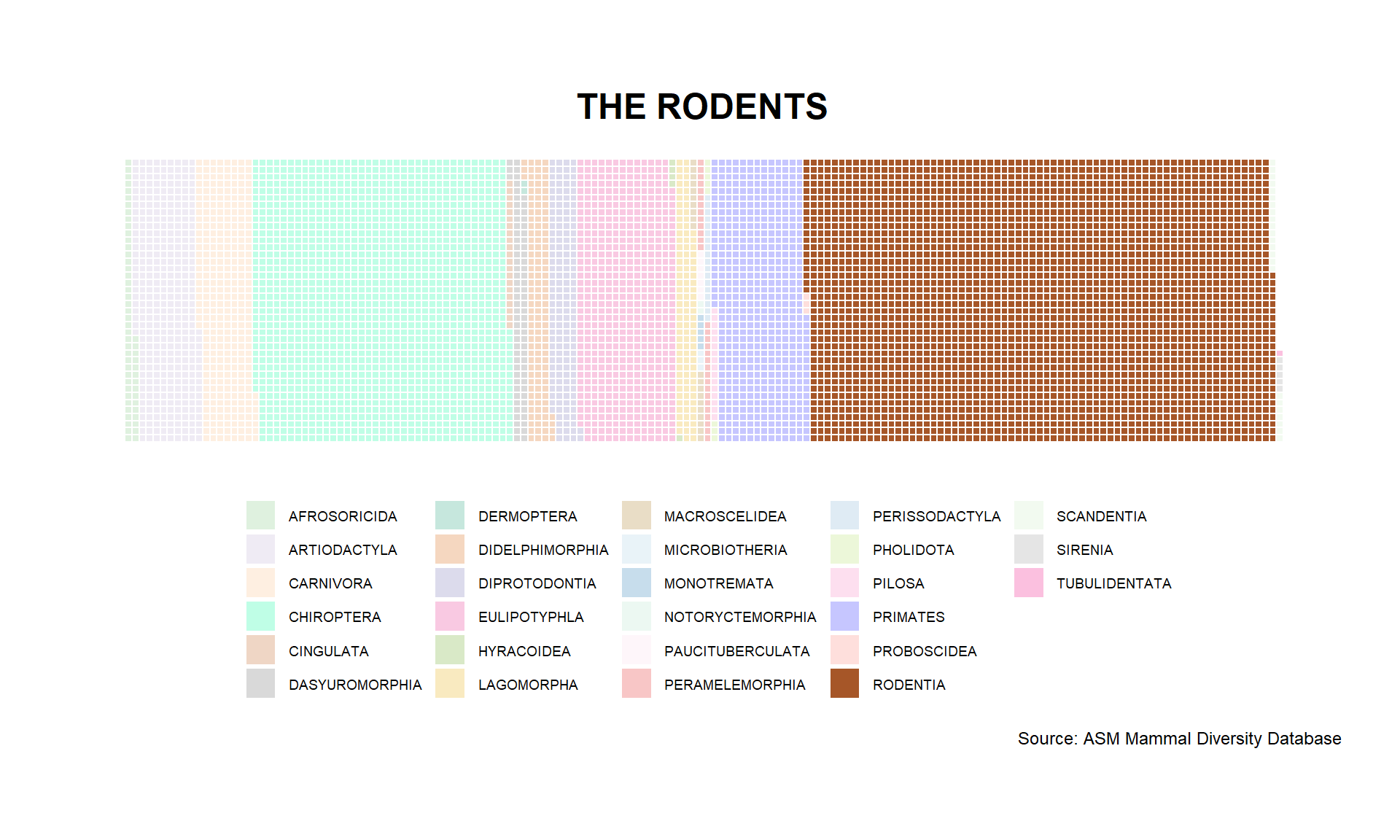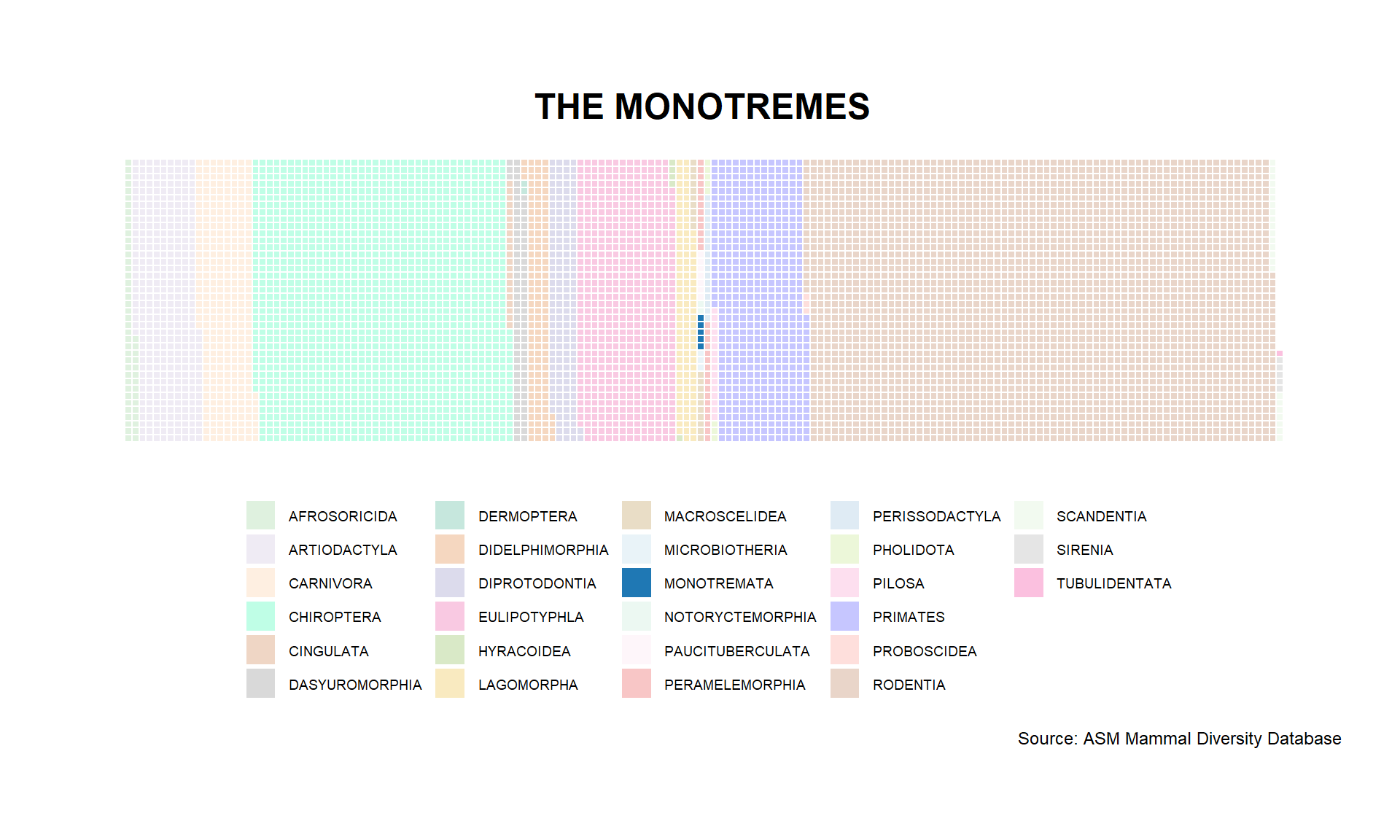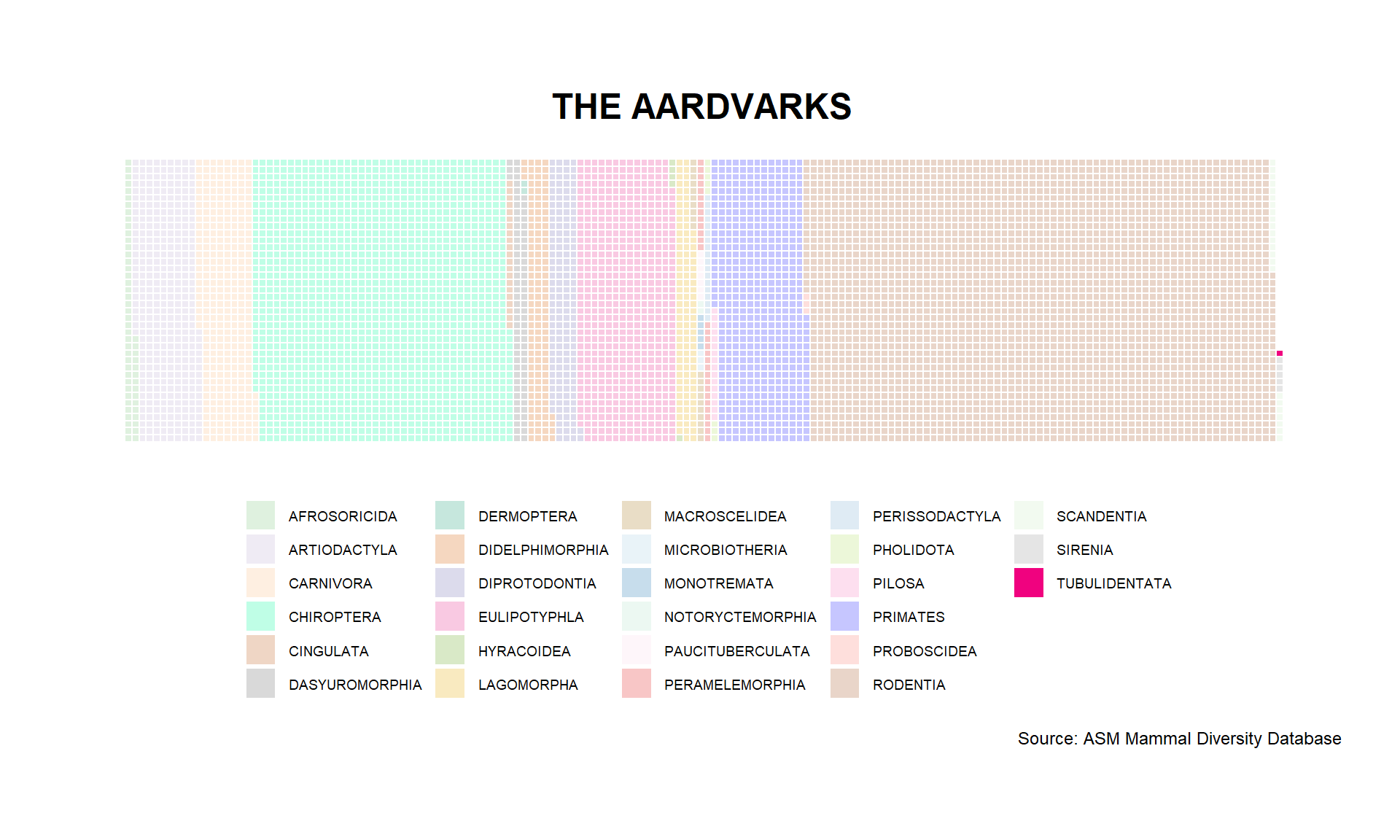Tubulidentata is the Loneliest Number...
Variety is the spice of life…sort of
The taxonomic1 class of Mammalia is composed of about 6,500 distinct species. From lightning quick as a cheetah to slow as a sloth, tiny to literally elephantine, and even dwelling in the oceans - no matter what or where, each species carries their young to term (monotremes excepted) and has mammary glands to produce milk for those offspring. But some are more represented than others.
There are 27 different orders in Class Mammalia, currently represented by 6,533 individual species. Let’s take a short tour of a few notable ones.

Some of the smallest are the biggest
When it comes to sheer number of differentiated species, the rodents take the cake and just about everything else. They account for 2,643 of them in the mammal class, 40% of all the species. They also exist pretty much everywhere; every continent except for Antarctica is home to numerous rodents. These aren’t just the destructive nuisances like mice, rats, and voles. Many of our cutest childhood pets are mere rodents - hamsters, guinea pigs, and gerbils are all members of Rodentia. But so are squirrels, prairie dogs, groundhogs, and even beavers. A truly immense group, as represented by the brown squares below.

For the only flying ones, there’s quite a variety
Chiroptera, the virtually omnipresent bat, gained more infamy following the events of 2020, but come in the second largest variety of all mammals - and are the only mammals that can fly. In fact, there are 1,449 different species of bats - still though, only a bit more than half of the different kinds of rodents. But with such a large group, there’s a lot of variation. The smallest bats are around 1.25 inches (32mm) long, and the largest about five and a half feet (1.7m). All those bats are in green below.

The Noble Apes
Then there are the primates. Modern humans (as well as not so modern ones), chimpanzees, orangutans, monkeys, all the other magnificent simians, and others such as lemurs. But the variety pales in comparison to the aforementioned groups. The bats outnumber primates nearly 3:1, and the vast catalog of rodent species outnumber them 5:1. There are 519 different types of primates, a total of only 8% of all the species of mammals.

Extreme monotremes
The monotremes deserve a closer look by virtue of their extremely strange characteristics for mammals. While they are the only mammals that do not carry their offspring to a live birth but, rather, lay an egg, they still provide nutrition to their young via mammary glands (though they lack nipples like other mammals). These odd creatures are a small group, with only five extant species - four echidnas, and the delightfully peculiar platypus. They’re noted in dark blue below.

Aardvark is the loneliest number
But all alone…yes, that single, solitary magenta point, all the way to the right, is the bemusing aardvark. Through cruel circumstance and perhaps poor design, Orycteropodidae (Aardvark Family) is the only remaining extant member of the Order Tubulidentata. So for all intents and purposes, all three of these keyboard workouts mentioned here are the same thing…what is commonly known as the aardvark. And it is the only mammal of its kind in our taxonomy. So this tiny data point below is a bit of a rarity. But luckily, there’s a lot of them. They are of least concern as deemed by the IUCN2, so they’re pretty robust as a species.

Orycteropus afer - Aardvark

Aside from rodents and bats, no other mammalian order is represented by more than 10% of all mammalian species. Indeed, 20 of the 27 orders contain less than even two percent (2%) of the variety in mammals. In fact, 17 of those orders contain species that total less than one percent (1%). And then there, all the way to the bottom, is the tubulidentata - flying solo, alone and free.
| Order | Number of Species | Percent |
|---|---|---|
| RODENTIA | 2643 | 40.46% |
| CHIROPTERA | 1449 | 22.18% |
| EULIPOTYPHLA | 554 | 8.48% |
| PRIMATES | 519 | 7.94% |
| ARTIODACTYLA | 361 | 5.53% |
| CARNIVORA | 311 | 4.76% |
| DIPROTODONTIA | 158 | 2.42% |
| DIDELPHIMORPHIA | 127 | 1.94% |
| LAGOMORPHA | 109 | 1.67% |
| DASYUROMORPHIA | 78 | 1.19% |
| AFROSORICIDA | 55 | 0.84% |
| PERAMELEMORPHIA | 30 | 0.46% |
| SCANDENTIA | 23 | 0.35% |
| CINGULATA | 21 | 0.32% |
| MACROSCELIDEA | 20 | 0.31% |
| PERISSODACTYLA | 18 | 0.28% |
| PILOSA | 16 | 0.24% |
| PHOLIDOTA | 8 | 0.12% |
| PAUCITUBERCULATA | 7 | 0.11% |
| HYRACOIDEA | 5 | 0.08% |
| MONOTREMATA | 5 | 0.08% |
| SIRENIA | 5 | 0.08% |
| MICROBIOTHERIA | 3 | 0.05% |
| PROBOSCIDEA | 3 | 0.05% |
| DERMOPTERA | 2 | 0.03% |
| NOTORYCTEMORPHIA | 2 | 0.03% |
| TUBULIDENTATA | 1 | 0.02% |
Data Source: ASM Mammal Diversity Database
Photo Source: https://upload.wikimedia.org/wikipedia/commons/3/35/Orycteropus_afer_stuffed.jpg
It can be correctly noted that our classification system is not devoid of an arbitrary nature. I am not contending on the merits, but it’s the lingua franca so is assumed to be common reference. It is also likely that our knowledge is severely lacking in many parts of the world.↩︎